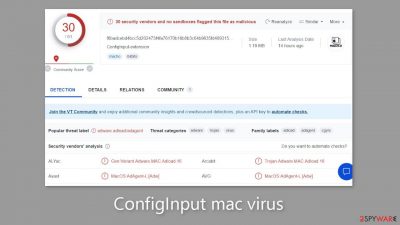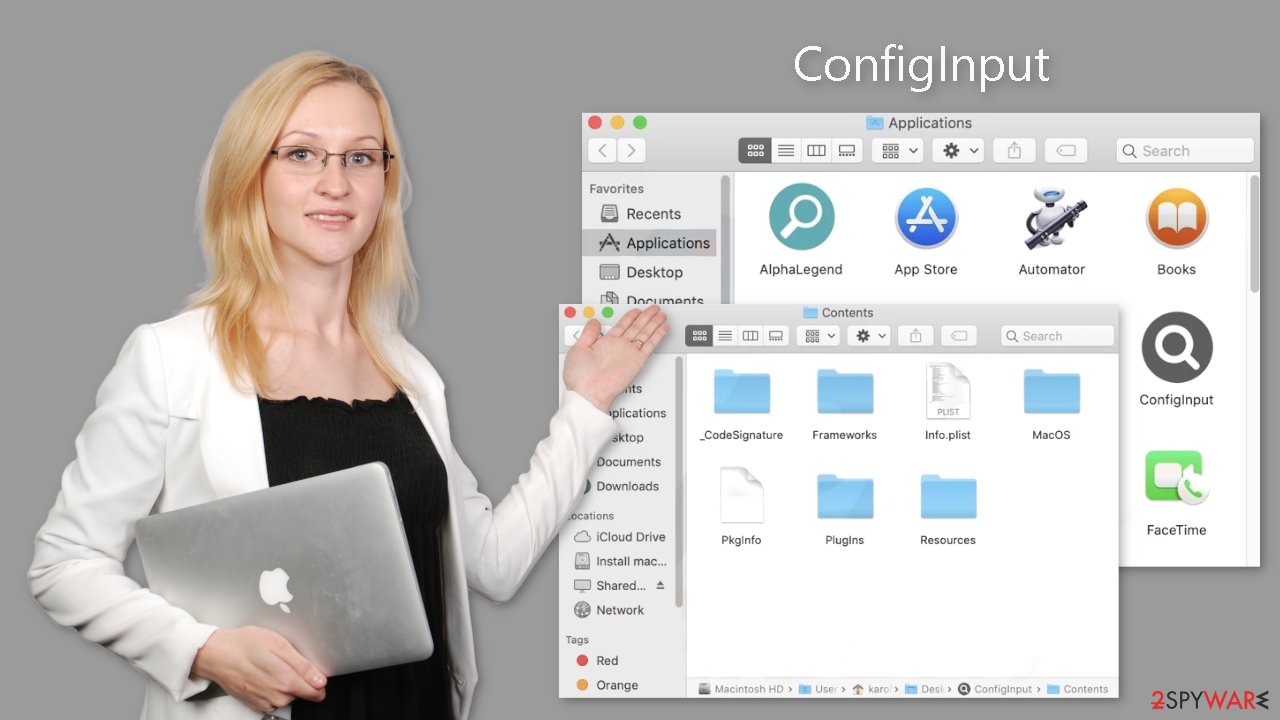ConfigInput mac virus (Free Instructions)
ConfigInput mac virus Removal Guide
What is ConfigInput mac virus?
ConfigInput is a virus created to specifically target Mac machines by clever cybercriminals

ConfigInput is a sophisticated virus with adware[1] and hijacking capabilities. It belongs to the Adload adware family and is specifically designed to target Mac computers. When a user's system is infected, they may experience an overload of commercial content, as well as frequent pop-ups, banners, and redirects. Furthermore, the virus has the ability to change important browser settings such as the homepage, new tab address, and default search engine.
Adware designed for Mac devices is more dangerous than adware designed for Windows machines. It employs a variety of evasion techniques, making removal difficult for users. Furthermore, ConfigInput can secretly install other potentially unwanted programs (PUPs) or malware onto the system without the user's knowledge.
There is a widespread misconception among Mac users that their systems are completely immune to modern threats. Malware developers, on the other hand, are constantly coming up with new ways to infect these machines. Adload's creators cleverly avoided Apple's security system, XProtect, by removing a specific strand of code, rendering their virus undetectable.
As a result, most users are unaware of the presence of ConfigInput until they notice erratic behavior on their machines. Those who choose to investigate may discover the virus in their “Applications” folder. We've previously discussed other Adload adware variants like ViewInput, SampleScheduler, and AssistiveTask. The icon they share – a magnifying glass set against a green, teal, or grey background – is a notable feature.
| NAME | ConfigInput |
| TYPE | Adware, browser hijacker, mac virus |
| MALWARE FAMILY | Adload |
| SYMPTOMS | Different homepage and new tab addresses; redirects to some other search engine and shady websites; machine performs worse than before; unknown apps appear on the machine |
| DISTRIBUTION | Fake software updates, deceptive ads, installing programs from peer-to-peer file-sharing platforms |
| DANGERS | Altered search results can lead to dangerous websites; pop-up ads might be promoting scams; the virus can install other PUPs or even malware in the background |
| ELIMINATION | Eliminating this Mac virus manually can be quite complicated. The easiest and most effective way would be to open a professional security tool and scan your system to delete every related file |
| FURTHER STEPS | FortectIntego should be used to completely wipe out any data left and fix the remaining damage |
Distribution methods
The prevalence of fake Flash Player[2] updates or installations is one of the primary causes of Adload infections, including ConfigInput. Malicious actors use social engineering techniques to trick people into thinking their Flash Player needs to be updated. They use deceptive messages to create a false sense of urgency, claiming that failure to install the most recent version will result in limited access to media content. Unfortunately, many people are unaware that Flash Player was phased out in 2020 and replaced by HTML5. If you come across any website that promotes otherwise, you must leave immediately.
Another major source of concern is the danger posed by torrent sites[3] and peer-to-peer file-sharing platforms. These unregulated environments become breeding grounds for malware. It is nearly impossible to determine whether a program you want to install is safe or secretly harbors a Trojan or other types of malware. Furthermore, one must be wary of bundled software, which freeware websites frequently include in the installation process.
To protect yourself from such threats, always use the “Custom” or “Advanced” installation methods, and read the Privacy Policy and Terms of Use carefully to understand the program's capabilities on your system. Examine the file list carefully and uncheck the boxes next to any unrelated files. Of course, installing software legally is the best practice. While there may be some costs involved, the long-term benefit is in maintaining a smooth-running system while avoiding potential malware harm.

Removal of ConfigInput mac virus
It is best to avoid attempting to delete files on your own if you are unfamiliar with the specific files you need to delete and the process involved. Some of these files may have a .plist extension, which indicates that they are standard settings files used by macOS applications to save configuration settings. Deleting the incorrect files may cause problems with various programs on your system.
Furthermore, the virus employs various persistence techniques and scatters files throughout the system, making complete removal difficult, particularly for browser extensions and applications associated with the malware.
For your peace of mind and to ensure thorough and safe removal, we strongly recommend using professional anti-malware tools SpyHunter 5Combo Cleaner or Malwarebytes. These tools are designed to detect unwanted programs and effectively eradicate them. Additionally, since you may not be aware if the virus has installed other malicious programs, using anti-malware software is the safest way to ensure your system is clean and protected.
If you still want to try and delete it manually, proceed with these steps:
- Open Applications folder
- Select Utilities
- Double-click Activity Monitor
- Here, look for suspicious processes related to adware and use Force Quit command to shut them down
- Go back to the Applications folder
- Find ConfigInput in the list and move it to Trash.
If you are unable to shut down the related processes or can't move the app to Trash, you should look for malicious profiles and login items:
- Go to Preferences and select Accounts
- Click Login items and delete everything suspicious
- Next, pick System Preferences > Users & Groups
- Find Profiles and remove unwanted profiles from the list.
There are likely to be more .plist files hiding in the following locations – delete them all:
- Select Go > Go to Folder.
- Enter /Library/Application Support and click Go or press Enter.
- In the Application Support folder, look for any dubious entries and then delete them.
- Now enter /Library/LaunchAgents and /Library/LaunchDaemons folders the same way and terminate all the related .plist files.
![Uninstall from Mac 2 Uninstall from Mac 2]()
The manual elimination process might not always result in full virus removal. Therefore, we still strongly suggest you perform a scan with security software.
Remove the extension gathering information
ConfigInput installs a browser extension that performs a variety of unwanted tasks, including potentially collecting and transmitting sensitive data to tracking servers. The user's IP address, macOS version, browser versions, computer ID, a list of items in the “Applications” folder, agents, daemons, and system configuration profiles may all be included in this data.
After you have successfully removed the malicious files from your system, you must remove the browser add-on as soon as possible. You can also use FortectIntego to automatically delete cookies and cache, as well as repair any damaged files and system errors. As a result, you should notice an improvement in the overall performance of your machine.
For those who prefer handling this task manually, below this article, you will find step-by-step instructions for removing the extension from Google Chrome and Mozilla Firefox.
- Click Safari > Preferences…
- In the new window, pick Extensions.
- Select the unwanted extension and select Uninstall.
![Remove extensions from Safari Remove extensions from Safari]()
Cookies and website data:
- Click Safari > Clear History…
- From the drop-down menu under Clear, pick all history.
- Confirm with Clear History.
![Clear cookies and website data from Safari Clear cookies and website data from Safari]()
The simplest and quickest solution to this is completely resetting Safari:
- Click Safari > Preferences…
- Go to Advanced tab.
- Tick the Show Develop menu in menu bar.
- From the menu bar, click Develop, and then select Empty Caches.
![Reset Safari Reset Safari]()
Getting rid of ConfigInput mac virus. Follow these steps
Remove from Mozilla Firefox (FF)
Remove dangerous extensions:
- Open Mozilla Firefox browser and click on the Menu (three horizontal lines at the top-right of the window).
- Select Add-ons.
- In here, select unwanted plugin and click Remove.

Reset the homepage:
- Click three horizontal lines at the top right corner to open the menu.
- Choose Options.
- Under Home options, enter your preferred site that will open every time you newly open the Mozilla Firefox.
Clear cookies and site data:
- Click Menu and pick Settings.
- Go to Privacy & Security section.
- Scroll down to locate Cookies and Site Data.
- Click on Clear Data…
- Select Cookies and Site Data, as well as Cached Web Content and press Clear.

Reset Mozilla Firefox
If clearing the browser as explained above did not help, reset Mozilla Firefox:
- Open Mozilla Firefox browser and click the Menu.
- Go to Help and then choose Troubleshooting Information.

- Under Give Firefox a tune up section, click on Refresh Firefox…
- Once the pop-up shows up, confirm the action by pressing on Refresh Firefox.

Remove from Google Chrome
Delete malicious extensions from Google Chrome:
- Open Google Chrome, click on the Menu (three vertical dots at the top-right corner) and select More tools > Extensions.
- In the newly opened window, you will see all the installed extensions. Uninstall all the suspicious plugins that might be related to the unwanted program by clicking Remove.

Clear cache and web data from Chrome:
- Click on Menu and pick Settings.
- Under Privacy and security, select Clear browsing data.
- Select Browsing history, Cookies and other site data, as well as Cached images and files.
- Click Clear data.

Change your homepage:
- Click menu and choose Settings.
- Look for a suspicious site in the On startup section.
- Click on Open a specific or set of pages and click on three dots to find the Remove option.
Reset Google Chrome:
If the previous methods did not help you, reset Google Chrome to eliminate all the unwanted components:
- Click on Menu and select Settings.
- In the Settings, scroll down and click Advanced.
- Scroll down and locate Reset and clean up section.
- Now click Restore settings to their original defaults.
- Confirm with Reset settings.

How to prevent from getting adware
Choose a proper web browser and improve your safety with a VPN tool
Online spying has got momentum in recent years and people are getting more and more interested in how to protect their privacy online. One of the basic means to add a layer of security – choose the most private and secure web browser. Although web browsers can't grant full privacy protection and security, some of them are much better at sandboxing, HTTPS upgrading, active content blocking, tracking blocking, phishing protection, and similar privacy-oriented features. However, if you want true anonymity, we suggest you employ a powerful Private Internet Access VPN – it can encrypt all the traffic that comes and goes out of your computer, preventing tracking completely.
Lost your files? Use data recovery software
While some files located on any computer are replaceable or useless, others can be extremely valuable. Family photos, work documents, school projects – these are types of files that we don't want to lose. Unfortunately, there are many ways how unexpected data loss can occur: power cuts, Blue Screen of Death errors, hardware failures, crypto-malware attack, or even accidental deletion.
To ensure that all the files remain intact, you should prepare regular data backups. You can choose cloud-based or physical copies you could restore from later in case of a disaster. If your backups were lost as well or you never bothered to prepare any, Data Recovery Pro can be your only hope to retrieve your invaluable files.
- ^ Lucian Constantin. What is adware? How it works and how to protect against it. Csoonline. Home Security.
- ^ Jamey Tucker. The dangers Adobe Flash Player pose for all computer users who still have it installed. Wrcbtv. Technology News.
- ^ Brad Haddin. 4 risks of using torrents. Creative. Tech Blog.











